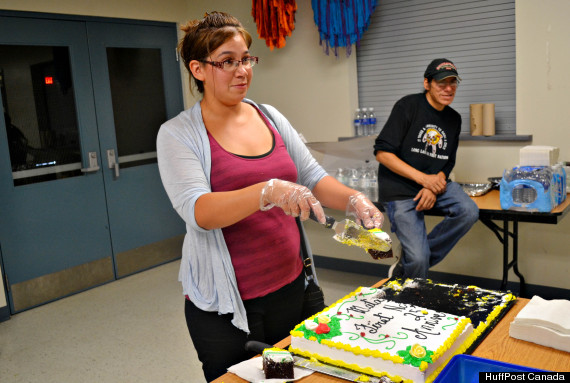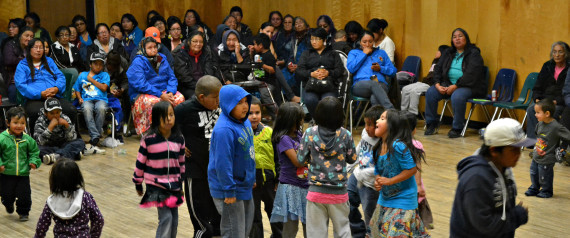First Nations Education: The Real Key To Ending The Cycle Of Despair
First Nations Education: The Real Key To Ending The Cycle Of Despair
By Sunny Freeman - Posted: 12/27/2013
Fed up with aboriginal people dependent on taxpayer funding, tired of suicide and poverty and drug addiction on reserves - these are the attitudes I expected from Canadians jaded by depressing headlines.
Instead, they are the sentiments I heard repeatedly from the First Nations people stuck living that grim reality. This year, I spent time with band members at high-level meetings, on the land and in homes in remote reserves while working on the HuffPost Canada series Staking Claim.
I learned most Canadians - aboriginal and non-aboriginal - recognize something is not just different, but very wrong on reserves in this country.
But the common ground ends there.
When I first suggested the series that became Staking Claim, I wanted to focus on how building a sustainable on-reserve economy could be the key to the elusive goal of self-sufficiency.
Instead, I learned the key to creating a functioning economy in First Nations communities starts with fixing the broken education system.
More from HuffPost Canada's Staking Claim series:
Few non-aboriginal Canadians have been to communities in the Far North, where three generations of two families might be cramped into one derelict government-owned house. Where schools close because the diesel generator dies, and where a nutritious breakfast costs three times what it would in my hometown, leaving many students too distracted by hunger to pay attention to their teachers. Often teachers are not aboriginal and are flown in for a short-term gig, so there are few role models.
Young people determined to stay in school face the pain of losing classmates to suicide or drug addiction.
These are just some of the overwhelming challenges that stack the odds against students in remote reserves, conditions that are unimaginable for many Canadians.
There is a wide gulf between how the federal government funds students on reserves and the spending per student in provincial school systems. Some estimates peg the amount of on-reserve funding at just half what other Canadian students receive.
During my visits to remote northern Ontario aboriginal communities, I met reserve members determined to improve the future for their own children. They want to change the legacy of the misguided residential school system that has created a cycle of poverty, joblessness and depression.
The stories of three particular students have stayed with me as testaments to why young people on reserves deserve better.
 HuffPost Canada
HuffPost Canada
LESSON #1: Many students struggle because they are forced to leave their communities to complete high school. Better funding would allow students to stay at home, where they have support systems.
At 16, Julianne Mequanawap left her eight brothers and sisters behind in Fort Hope, a fly-in community that can't afford a high school. After she stepped off the plane in Thunder Bay, she was promptly dropped off at a stranger's home.
Living away from home is scary and lonely, and she had to face new challenges without friends or family. She eventually got kicked out of a Thunder Bay high school.
Now 20, Julianne is in grade 12 at the Matawa Learning Centre, an aboriginal-led alternative education centre. She will be the first one in her family to graduate high school and won the attendance award last year.
Julianne wants to go to college for social work and return to help the youth in her community.
"I want to show them it's possible, that it's not too late."

Renee Wesley cuts cake to celebrate Matawa's 25th anniversary. She works at the band's community centre in the summer when she is not in school.
LESSON #2: Better funding to build schools in aboriginal communities would provide opportunity and incentive to strive for something better.
Renee Wesley found salvation in school portables.
At 16, Renee dropped out of high school in Geraldton, a town two hours away from her home on the Long Lake #58 reserve. She had gotten wrapped up in drugs, at first marijuana, then Oxycontin and Percocet. When she was on them she didn't feel the depression and anxiety that so often plagued her.
Now 26, Renee kicked her drug addiction when the community launched its own suboxone treatment program. She did it for her children and soon decided she wanted more than what her Grade 10 education could offer her.
"I realized I couldn't give them everything that I had because I was so much into drugs and I've always been a smart person. It's just that maybe depression got the best of me."
Once clean, she saw the community's newly opened portables for high school students as the perfect opportunity to turn her life around. She wouldn't have gone back to school if she still had to commute out of town. Earlier this fall, Long Lake #58 proudly opened the doors to its first permanent high school, complete with computer lab and gym.
The at-home high school allows her time to drop her two-year-old off at daycare and her nine-year-old off at school and return to fix them lunch.
She's been clean for five years and is in her last year of high school. She wants to continue with her education, but isn't sure how.
Renee wishes she could defend other vulnerable community members. She dreams of becoming a lawyer.
"I see a lot of aboriginal people get the short end of the stick when they go to court, they don't want to get represented because they don't have money."
Renee is confident life will be different for her children. When she was growing up there was no wellness program, no elementary school, no mentorship or recreational programming.
"We didn't really have [any] jobs or anything to look forward to, so I think that's why a lot of students just ended up quitting school and doing drugs."
She hopes her return to school will be an inspiration to her daughters.
"I just hope that they finish school and get a degree so they can have good lives."
LESSON #3: Without a concerted effort to improve education and provide opportunities, there is no hope for ambitious community members.
Terry Yesno has trained to be a firefighter, a mining claims staker and a diamond driller. Yet he has no job prospects, and is entering a new program to be a heavy equipment operator.
Terry lives in Webequie, a two-hour flight north of Thunder Bay. He graduated from high school in 2005, and immediately trained as a firefighter and has been training in other fields ever since in hopes of landing a job.
He does menial duties in a mining camp, which provides him with work for about three months of the year. After speaking with a friend making more money as a driller, he was inspired to retrain for a job he believed would be in demand given the influx of mining activity in the Ring of Fire region east of his reserve.
The 35-year-old completed training as a diamond driller last December, expecting to find more steady work within a few months. He sent out resumes to mining companies active in the area, as well as for jobs farther away that would require him to leave his family, and even followed up with a phone call for some.
But after more than six months of looking for drilling jobs, Terry decided it wasn't enough. This summer he was accepted into a training course to be a heavy equipment operator.
"I'm going to keep trying and trying," he laughs.
"I just want to work. I just like working."
***
Today, First Nations education is at an under-reported crossroads.
The federal government is pushing the First Nations Education Act to overhaul on-reserve schooling. It would give federal officials the power to take over schools if they don't meet provincial standards, but puts off the all-important question of funding.
Many of the aboriginal people affected are outraged, saying their leaders haven't been properly consulted. Given the long, twisted history of First Nations education (see: Harper's 2008 apology for residential schools), "skeptical" is an understatement to describe how they feel.
However, their reliance on government funding means they are ultimately voiceless. Meanwhile, the people with the strongest voice, voters in the rest of Canada who could influence the government, have been largely silent.
The Act will push the issue of First Nations education into the political arena for the first time in many years. It is a chance to start an important discussion: We must find a way to bridge the education gap so that young people on reserves grow up with a level of education on par with that of every other publicly funded student in Canada.
The lessons I have learned over the past year add up to one truth: Education is the cornerstone in the path to First Nations self-sufficiency, to end that dependency on government funding, and to create new relationships that provide equal opportunities for all Canadians.










